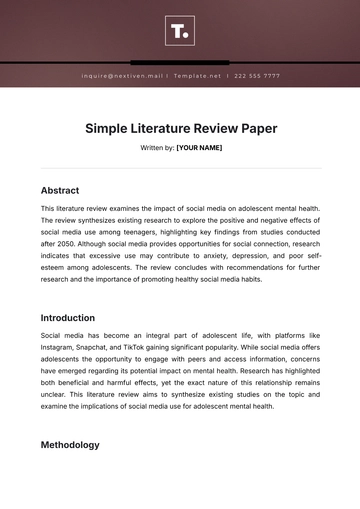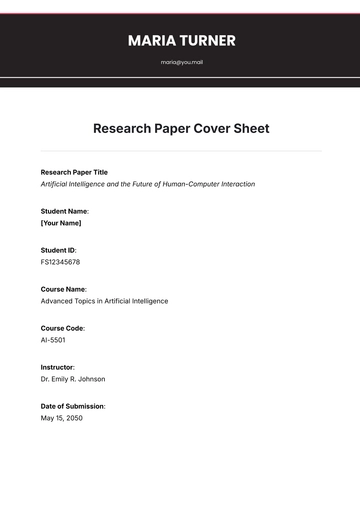Free Market Research White Paper

Comprehensive Market Research
Prepared By: [Your Name]
Position: [Your Position]
Company Name: [Your Company Name]
Date: [Date]

I. Executive Summary
The Executive Summary provides a concise overview of the key findings and insights of the market research.
Synopsis of Findings: A condensed summary of the market trends, consumer behavior patterns, competitive landscape analysis, and future projections elucidated in the white paper.
Significant Insights: Highlighting notable opportunities and challenges identified within the market, along with actionable recommendations for stakeholders.
II. Introduction
The Introduction section sets the stage for the market research by providing background information and objectives.
Market Overview: A concise overview of the market or industry under examination, highlighting key characteristics, trends, and dynamics shaping its landscape.
Research Objectives: Clear articulation of the purpose and goals of the market research, elucidating the specific questions or issues the study aims to address.
III. Methodology
The Methodology section outlines the approach and techniques used to conduct the market research.
Description of Research Methods: Comprehensive overview of the research methodologies utilized, encompassing both qualitative and quantitative approaches. This includes details on data collection techniques such as surveys, interviews, focus groups, and secondary research sources such as industry reports and databases.
Explanation of Sample Size and Demographics: Insights into the sample size and demographics of the study population, including relevant characteristics such as age, gender, income, and geographic location. This information provides context for interpreting research findings and ensures the representativeness of the sample.
IV. Market Trends
The Market Trends section delves into the current and emerging trends within the market.
Recent Developments: Analysis of recent impactful trends with supporting data.
Emerging Trends: Discussion of emerging market trends and their potential implications.
Key Drivers: Identification of primary factors driving market trends.
Implications: Brief overview of implications for stakeholders, with actionable recommendations.
V. Consumer Behavior
This section provides insights into consumer demographics and psychographics, as well as factors influencing their decision-making.

Demographics: Analysis of consumer characteristics like age, gender, and location.
Psychographics: Understanding consumer lifestyles, values, and interests.
Decision Factors: Discussion on how product features, pricing, brand perception, social influence, and convenience affect consumer choices.
VI. Competitive Landscape
This section evaluates the competitive environment of the market, crucial for understanding industry dynamics and positioning strategies.
Overview of Major Competitors: Examination of key competitors and their respective market shares, providing insights into the competitive landscape's composition and dominance.
Analysis of Competitive Strategies: Insightful examination of the strategies employed by competitors, including pricing, product differentiation, marketing tactics, and distribution channels. Understanding these strategies helps identify areas for differentiation and competitive advantage.
Positioning Analysis: Evaluation of competitors' positioning within the market, highlighting their strengths, weaknesses, opportunities, and threats. This analysis aids in crafting effective positioning strategies to capitalize on market opportunities and mitigate competitive threats.
VII. Future Projections
This section offers forecasts and insights into the future trajectory of the market, aiding stakeholders in strategic planning and decision-making.
Market Growth Projections: Forecasts on market growth rates and expansion opportunities based on current trends and anticipated developments. These projections assist in identifying potential areas for investment and growth strategies.
Discussion of Disruptors: Analysis of potential disruptors and challenges that may impact the market in the future. This includes technological advancements, regulatory changes, economic fluctuations, and emerging competition. Understanding these disruptors helps businesses adapt and innovate to stay competitive.
VIII. Conclusion
This section summarizes the key findings of the market research and provides actionable insights for stakeholders to consider.
Recap of Main Insights: A concise summary of the key insights gained from the market research, including trends, consumer behavior, competitive landscape, and future projections. This recap serves as a reminder of the most significant findings for stakeholders.
Implications for Stakeholders: Analysis of the implications of the research findings for stakeholders, including [Your Company Name] and others in the industry. This discussion highlights opportunities to capitalize on and challenges to address in the evolving market landscape.
Recommendations: Actionable recommendations for [Your Company Name] and other stakeholders based on the insights gleaned from the research. These recommendations may include strategic initiatives, marketing strategies, product development opportunities, or operational improvements aimed at driving success in the market.
IX. References
The References section lists all sources cited throughout the white paper. List all of academic papers, industry reports, and other references used in the research.
- 100% Customizable, free editor
- Access 1 Million+ Templates, photo’s & graphics
- Download or share as a template
- Click and replace photos, graphics, text, backgrounds
- Resize, crop, AI write & more
- Access advanced editor
Introducing the Market Research White Paper Template, exclusively on Template.net. Crafted for industry leaders, it's both editable and customizable, ensuring your insights shine through. With our Ai Editor Tool, refine details effortlessly to suit your vision. Elevate your research with this versatile template, designed to captivate audiences and showcase your expertise in the market landscape.





























